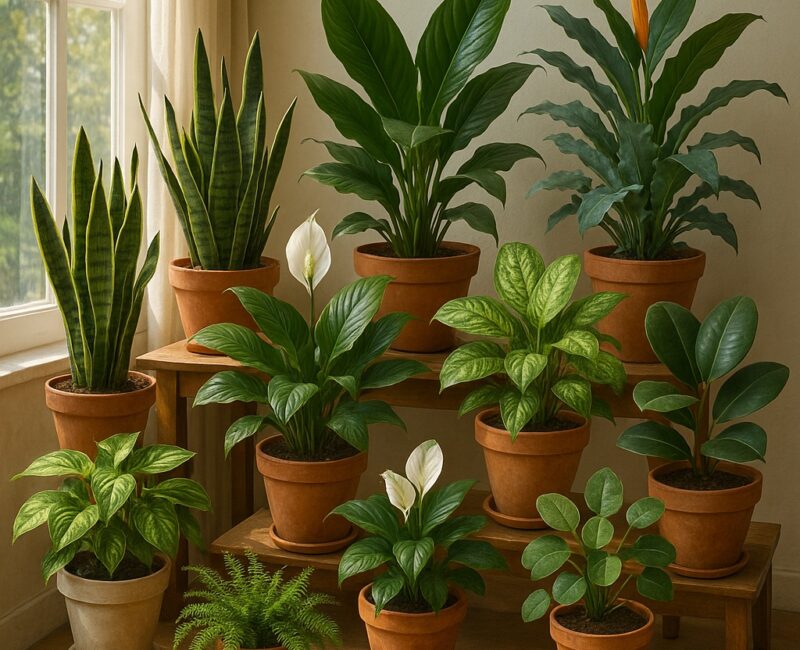Why Indoor Air Quality Matters More Than You Think
Most people assume pollution is only an outdoor problem, but the truth is shocking—indoor air can be 2 to 5 times more polluted than the air outside. Everyday household items like cleaning sprays, furniture polish, synthetic fabrics, and even paints release volatile organic compounds (VOCs) that harm our health.
Prolonged exposure to these toxins may cause headaches, fatigue, allergies, or even long-term respiratory issues. That’s why indoor air quality isn’t just a comfort factor—it’s a health necessity.
Common Indoor Pollutants Affecting Your Health
Some of the most common indoor air pollutants include:
- Formaldehyde (from furniture and flooring)
- Benzene (from paints and plastics)
- Trichloroethylene (from cleaning products)
- Carbon monoxide (from stoves and heaters)
- Mold spores and dust (from damp spaces)
Why Machines Aren’t Always the Best Air Cleaners
Air purifiers are popular, but they have limitations:
- They require constant electricity and filter replacements.
- Many models don’t remove all types of pollutants.
- They can be noisy and add to your household bills.
Nature, however, offers a low-cost, low-maintenance solution—plants.
How Plants Purify Indoor Air Naturally
Plants act as natural filters by absorbing pollutants through their leaves and roots. They break down toxins into harmless byproducts while also releasing oxygen and improving humidity levels.
The Science Behind Air-Purifying Plants
Research shows that certain plants remove up to 87% of indoor toxins within 24 hours under the right conditions.
NASA Clean Air Study Findings
In the late 1980s, NASA conducted its famous Clean Air Study, which confirmed that specific plants—like the Snake Plant and Peace Lily—are especially effective at eliminating harmful compounds.
Top 12 Plants That Clean Indoor Air Better Than Machines
1. Snake Plant
- Air toxins removed: Benzene, formaldehyde, and trichloroethylene
- Benefits: Works even at night, making it perfect for bedrooms
- Best placement: Near windows or low-light corners
2. Peace Lily
- Air toxins removed: Mold spores, VOCs, and formaldehyde
- Extra benefits: Beautiful white flowers and low maintenance
3. Aloe Vera
- Air toxins removed: Formaldehyde and benzene
- Healing properties: Great for burns and skin care
4. Boston Fern
Air toxins removed: Formaldehyde and xylene
- Care tip: Loves humidity—best for bathrooms or kitchens
5. Spider Plant
- Air toxins removed: Carbon monoxide and formaldehyde
- Best placement: Ideal for living rooms and offices
6. Areca Palm
- Air toxins removed: Toluene and xylene
- Bonus: Acts as a natural humidifier
7. Rubber Plant
- Air toxins removed: Formaldehyde
- Care tip: Thrives in bright, indirect light
8. Bamboo Palm
- Air toxins removed: Benzene and trichloroethylene
- Placement: Corners of living rooms or hallways
9. Chrysanthemum
- Air toxins removed: Ammonia and benzene
- Extra benefit: Bright, colorful blooms
10. English Ivy
- Air toxins removed: Mold and airborne fecal matter
- Perfect placement: Bathrooms or damp areas
11. Gerbera Daisy
- Air toxins removed: Trichloroethylene and benzene
- Extra benefit: Adds vibrant color while boosting oxygen
12. ZZ Plant
- Air toxins removed: Xylene and toluene
- Care tip: Perfect for low-light spaces
Tips for Caring for Air-Purifying Plants
Having air-purifying plants is only half the journey—keeping them healthy is what ensures maximum air-cleaning benefits. Here are some essential tips:
Light, Water & Soil Requirements
- Light: Most air-purifying plants thrive in indirect sunlight. Direct harsh light may scorch leaves, while too little light can stunt growth.
- Water: Overwatering is the number one mistake plant owners make. Always check soil moisture before watering. Many of these plants prefer slightly damp but not soggy soil.
- Soil: A well-draining potting mix ensures roots don’t sit in water, preventing root rot. Adding peat moss, perlite, or sand can improve drainage.
Mistakes to Avoid When Growing Indoors
- Avoid placing plants near heaters or air conditioners, as extreme temperatures damage them.
- Don’t use chemical fertilizers excessively, as they may release toxins back into your home.
- Always wipe plant leaves to remove dust—clean leaves absorb toxins better.
Combining Plants for Maximum Air Purification
While a single plant can purify a room, combining multiple types creates a stronger, more natural filtration system.
Best Plant Pairings for Living Rooms & Bedrooms
- Living Room: Snake Plant + Areca Palm + Spider Plant → Removes VOCs, improves oxygen, and boosts humidity.
- Bedroom: Snake Plant + Aloe Vera → Both release oxygen at night, supporting better sleep.
- Office Space: Rubber Plant + Peace Lily → Tackle stress while removing toxins from electronics and cleaning agents.
By mixing tall plants (like palms) with tabletop plants (like Aloe Vera), you maximize both aesthetic appeal and air-cleaning efficiency.
Are Plants Enough? Balancing Nature & Technology
While these plants are powerful air filters, it’s important to keep expectations realistic. Plants work best as complements to good ventilation and occasional air filtration, not always complete replacements.
When You Might Still Need an Air Purifier
- If you live in a city with heavy outdoor pollution.
- If your home has pets, smokers, or strong allergens.
- If anyone in the household suffers from serious asthma or respiratory issues.
That said, plants provide holistic benefits—they not only purify air but also reduce stress, increase productivity, and bring life into your home in ways machines never can.
Breathe Easier with Nature’s Air Filters
When it comes to air purification, plants are more than just pretty decorations—they’re natural healers. The Top 12 plants that clean indoor air better than machines not only filter toxins but also improve your mood, boost productivity, and bring nature indoors.
By strategically placing these plants throughout your home, you can create a healthier, fresher, and more vibrant environment—all without relying solely on expensive machines.
So next time you’re thinking about an air purifier, consider adding one of these green allies to your space. After all, sometimes nature’s simplest solutions turn out to be the most powerful. 🌿





